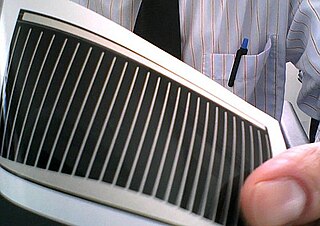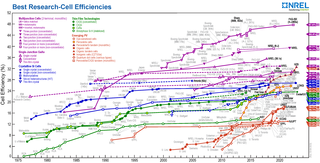
Photovoltaics (PV) is the conversion of light into electricity using semiconducting materials that exhibit the photovoltaic effect, a phenomenon studied in physics, photochemistry, and electrochemistry. The photovoltaic effect is commercially used for electricity generation and as photosensors.

The National Renewable Energy Laboratory (NREL) in the US specializes in the research and development of renewable energy, energy efficiency, energy systems integration, and sustainable transportation. NREL is a federally funded research and development center sponsored by the Department of Energy and operated by the Alliance for Sustainable Energy, a joint venture between MRIGlobal and Battelle. Located in Golden, Colorado, NREL is home to the National Center for Photovoltaics, the National Bioenergy Center, and the National Wind Technology Center.
In the 19th century, it was observed that the sunlight striking certain materials generates detectable electric current – the photoelectric effect. This discovery laid the foundation for solar cells. Solar cells have gone on to be used in many applications. They have historically been used in situations where electrical power from the grid was unavailable.

Cadmium telluride (CdTe) is a stable crystalline compound formed from cadmium and tellurium. It is mainly used as the semiconducting material in cadmium telluride photovoltaics and an infrared optical window. It is usually sandwiched with cadmium sulfide to form a p–n junction solar PV cell.

A solar cell, or photovoltaic cell, is an electronic device that converts the energy of light directly into electricity by the photovoltaic effect, which is a physical and chemical phenomenon. It is a form of photoelectric cell, defined as a device whose electrical characteristics, such as current, voltage, or resistance, vary when exposed to light. Individual solar cell devices are often the electrical building blocks of photovoltaic modules, known colloquially as solar panels. The common single junction silicon solar cell can produce a maximum open-circuit voltage of approximately 0.5 volts to 0.6volts.

A solar cell panel, solar electric panel, photo-voltaic (PV) module, PV panel or solar panel is an assembly of photovoltaic solar cells mounted in a frame, and a neatly organised collection of PV panels is called a photovoltaic system or solar array. Solar panels capture sunlight as a source of radiant energy, which is converted into electric energy in the form of direct current (DC) electricity. Arrays of a photovoltaic system can be used to generate solar electricity that supplies electrical equipment directly, or feeds power back into an alternate current (AC) grid via an inverter system.

First Solar, Inc. is an American manufacturer of solar panels, and a provider of utility-scale PV power plants and supporting services that include finance, construction, maintenance and end-of-life panel recycling. First Solar uses rigid thin-film modules for its solar panels, and produces CdTe panels using cadmium telluride (CdTe) as a semiconductor. The company was founded in 1990 by inventor Harold McMaster as Solar Cells, Inc. and the Florida Corporation in 1993 with JD Polk. In 1999 it was purchased by True North Partners, LLC, who rebranded it as First Solar, Inc.
Global Solar Energy is a US-based manufacturer of CIGS solar cells, a thin-film based photovoltaic technology, with manufacturing operations in Tucson, Arizona, United States, and Berlin, Germany. In 2013, it was bought by Chinese renewable energy company Hanergy.

Cadmium telluride (CdTe) photovoltaics is a photovoltaic (PV) technology based on the use of cadmium telluride in a thin semiconductor layer designed to absorb and convert sunlight into electricity. Cadmium telluride PV is the only thin film technology with lower costs than conventional solar cells made of crystalline silicon in multi-kilowatt systems.

A thin-film solar cell is a second generation solar cell that is made by depositing one or more thin layers, or thin film (TF) of photovoltaic material on a substrate, such as glass, plastic or metal. Thin-film solar cells are commercially used in several technologies, including cadmium telluride (CdTe), copper indium gallium diselenide (CIGS), and amorphous thin-film silicon.

Worldwide growth of photovoltaics has been close to exponential between 1992 and 2018. During this period of time, photovoltaics (PV), also known as solar PV, evolved from a niche market of small-scale applications to a mainstream electricity source.

A copper indium gallium selenide solar cell is a thin-film solar cell used to convert sunlight into electric power. It is manufactured by depositing a thin layer of copper indium gallium selenide solution on glass or plastic backing, along with electrodes on the front and back to collect current. Because the material has a high absorption coefficient and strongly absorbs sunlight, a much thinner film is required than of other semiconductor materials.
Arthur J. Nozik is a researcher at the National Renewable Energy Lab (NREL). He is also a professor at the University of Colorado, which is located in Boulder. He researches semiconductor quantum dots at the National Renewable Energy Laboratory, and is a chemistry professor at the University of Colorado. He also does research for the advancement of solar energy, for which he won the Intergovernmental Renewable Energy Organization (IREO) Award for Science and Technology in 2009.

Crystalline silicon or (c-Si) Is the crystalline forms of silicon, either polycrystalline silicon, or monocrystalline silicon. Crystalline silicon is the dominant semiconducting material used in photovoltaic technology for the production of solar cells. These cells are assembled into solar panels as part of a photovoltaic system to generate solar power from sunlight.

Nanocrystal solar cells are solar cells based on a substrate with a coating of nanocrystals. The nanocrystals are typically based on silicon, CdTe or CIGS and the substrates are generally silicon or various organic conductors. Quantum dot solar cells are a variant of this approach, but take advantage of quantum mechanical effects to extract further performance. Dye-sensitized solar cells are another related approach, but in this case the nano-structuring is part of the substrate.
Photoelectrochemistry is a subfield of study within physical chemistry concerned with the interaction of light with electrochemical systems. It is an active domain of investigation. One of the pioneers of this field of electrochemistry was the German electrochemist Heinz Gerischer. The interest in this domain is high in the context of development of renewable energy conversion and storage technology.
Solar energy – radiant light and heat from the sun. It has been harnessed by humans since ancient times using a range of ever-evolving technologies. Solar energy technologies include solar heating, solar photovoltaics, solar thermal electricity and solar architecture, which can make considerable contributions to solving some of the most urgent problems that the world now faces.

Solar Frontier Kabushiki Kaisha is a Japanese photovoltaic company that develops and manufactures thin film solar cells using CIGS technology. It is a fully owned subsidiary of Showa Shell Sekiyu and located in Minato, Tokyo, Japan. The company was founded in 2006 as Showa Shell Solar, and renamed Solar Frontier in April 2010.
1. I.M. Dharmadasa, J. Young, A.P. Samantilleke. N.B. Chaure, and T. Delsol (i) Copper-indium based thin film PV devices and methods of making the same; WO 03/043096 (ii) Thin film PV devices and method of making the same; GB0405707.1-published as 2397944A (iii) Design of II-VI and III-V thin film PV devices; GB0405710.5 - published as 2397945A (iv) CdTe based multi-layer graded band gap PV devices; GB0405718.8 - published as 2397946A (v) Fabrication of Semiconductor Devices; GB0308826.7-published on 20 Oct. 2004 as GB2400725A (vi) Thin Film photovoltaic device and method of making the same, GB 0202007.1
2. IM Dharmadasa. Recent developments and progress on electrical contacts to CdTe, CdS and ZnSe with special reference to barrier contacts to CdTe. Prog. Crystal Growth and Charact. 36 (1998), pp. 249–290.
3. IM Dharmadasa, AP Samantilleke, J Young and NB Chaure. New ways of development of Glass/CG/CdS/CdTe/metal thin film solar cells based on a new model. Semicond. Sci. Technol. 17 (2002), pp. 1238–1248. ( http://www.iop.org/EJ/abstract/0268-1242/17/12/306/ )
4. X Wu, JC Keane, RG Dhere, C Dehart, DS Albin, A Duda, TA Gessert, S Asher, DH Levi and P Sheldon. Proc. of 17th European Photovoltaic Solar Energy Conference. Munich, Germany, 22–26 October 2001, pp. 995–1000.
5. IM Dharmadasa. Photovoltaic technology for developing countries; The way forward. Proc. of the workshop on Low Cost Electronic Materials and Solar Cells, Colombo-Sri Lanka, 5–6 March 1997, pp. 1–9.
6. IM Dharmadasa. Clean Energy for the future; the role of photovoltaics as an energy source for the twenty first century. Proc. of the workshop on Renewable Energy Sources Colombo, Sri Lanka, 10–11 February 1998, pp. 1–6.
7. IM Dharmadasa. Solar Energy for a Healthy Society, Part I, Lanka Outlook, Winter (1997/98), pp. 36–37.
11. IM Dharmadasa. Solar Energy for a Healthy Society, Part II, Lanka Outlook, Spring (1998), pp. 36–38.











